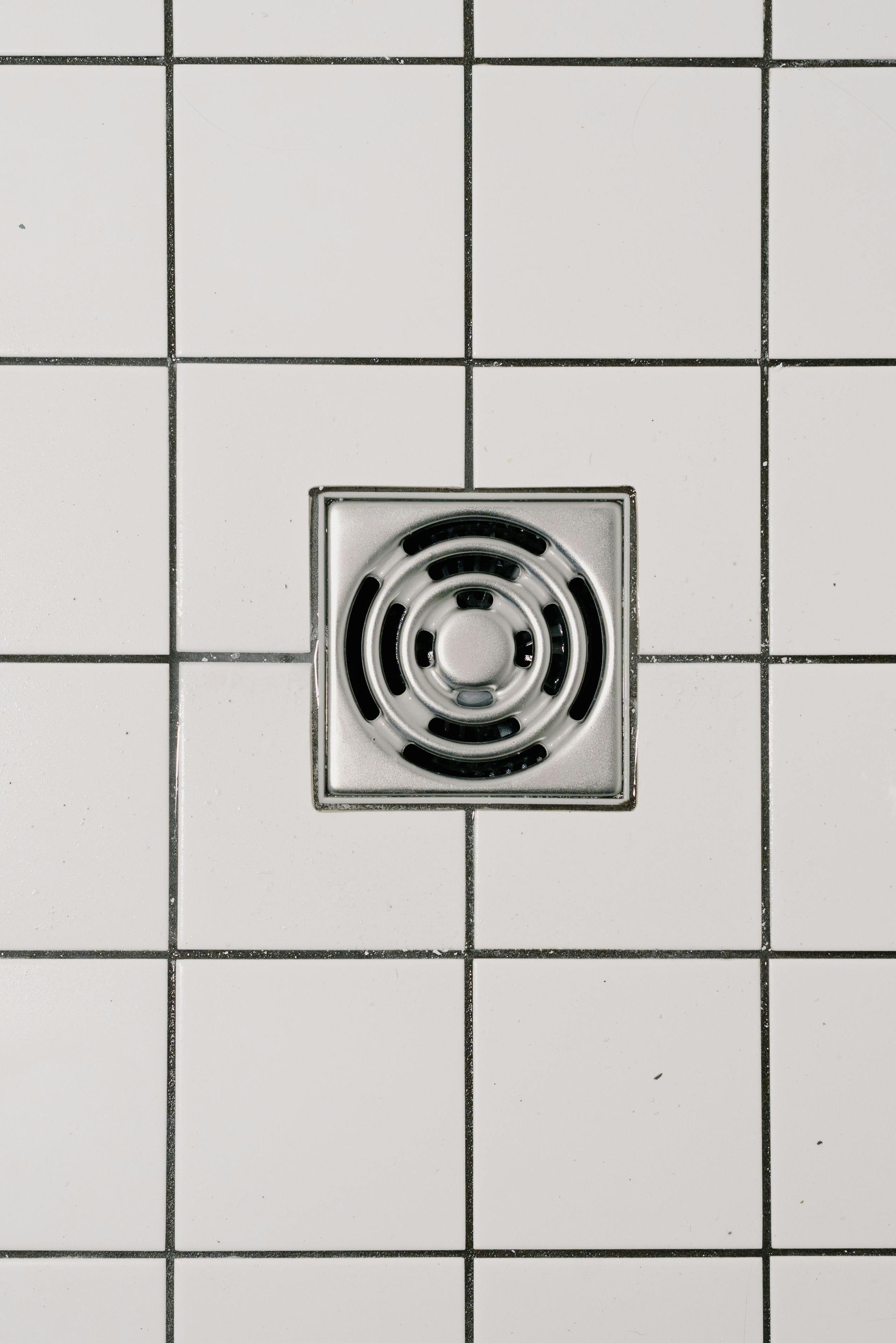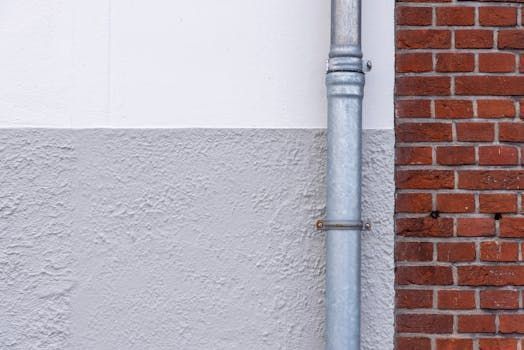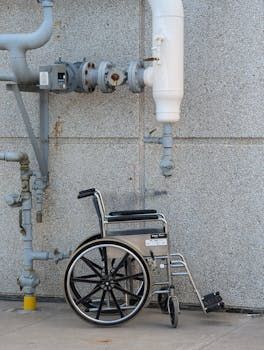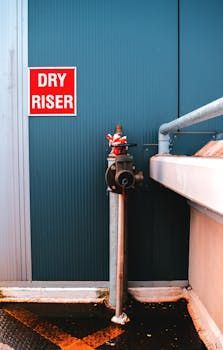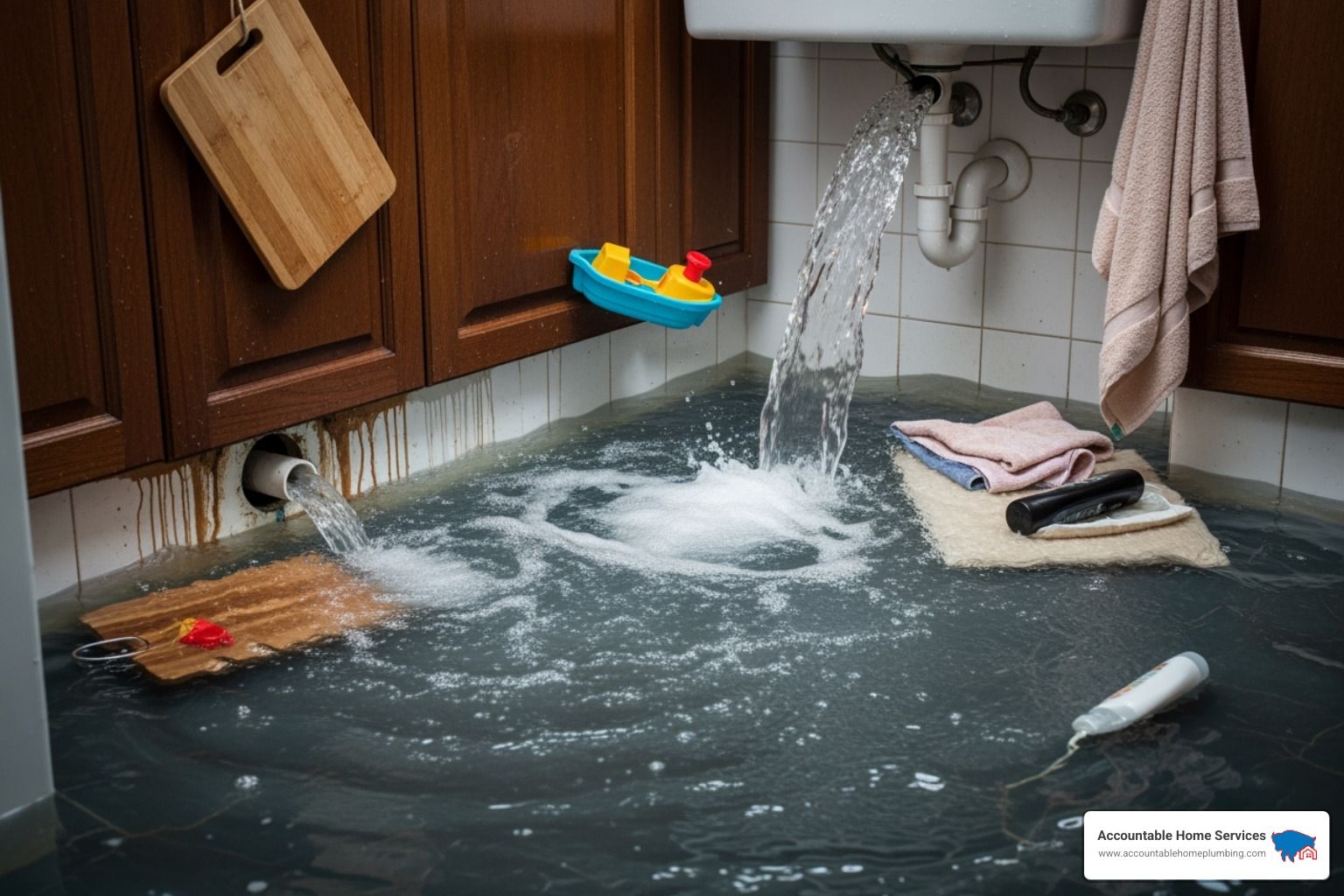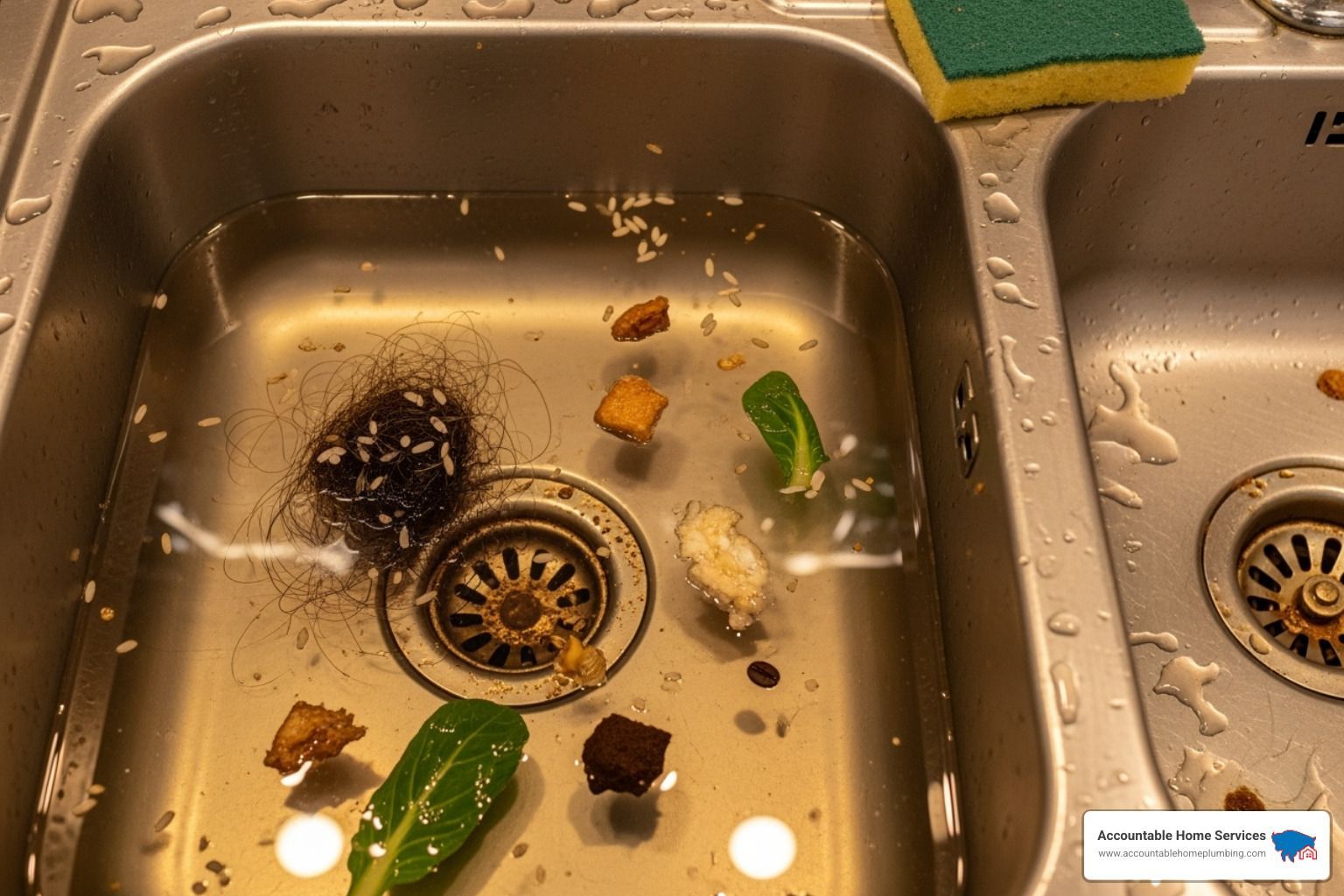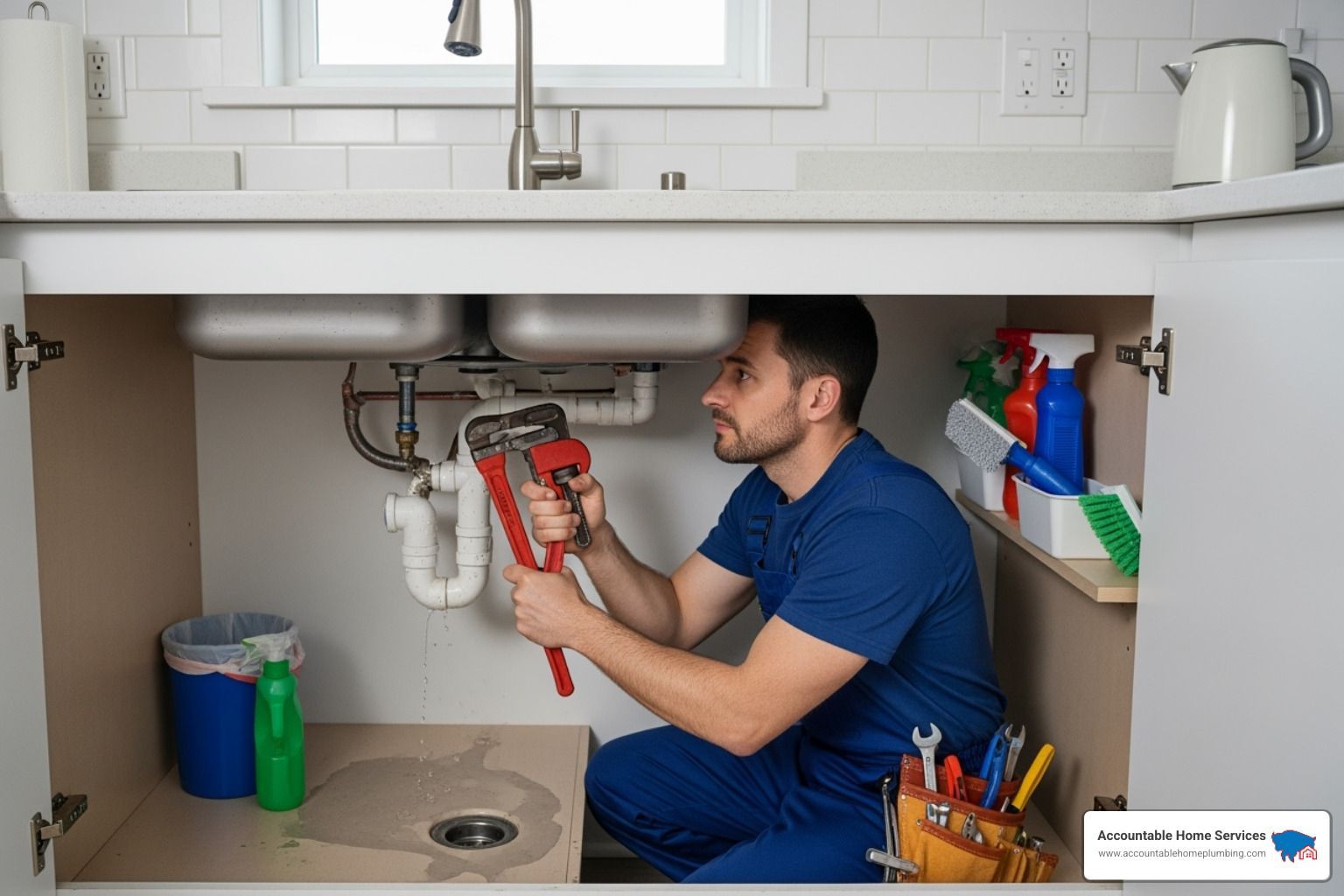How to Clear a Basin Choke Like a Pro (No Plumber Needed!)
The Frustration of a Clogged Basin: Quick Solutions
If you're dealing with a basin choke solution, here's a quick guide to fix your clogged sink:
- Pour boiling water directly into the drain (only for metal pipes)
- Try the baking soda and vinegar method (½ cup of each, wait 20 minutes, flush with hot water)
- Use a plunger designed for sinks (create a seal and pump for 15 seconds)
- Clean the P-trap by placing a bucket underneath, unscrewing the connections, and removing debris
- Use a Zip-It tool or drain snake to pull out hair and buildup
A basin choke solution doesn't have to involve calling a professional plumber or spending money on expensive chemicals. That slow-draining bathroom sink is one of the most common household plumbing issues, and in most cases, you can fix it yourself with items you already have at home.
When water begins pooling around your drain or takes forever to disappear, it's a clear sign of a basin choke - plumber speak for a clogged sink drain. These clogs typically form when hair, soap scum, toothpaste residue, and other debris build up over time, creating a barrier that prevents water from flowing freely.
I'm Mike Martinez, owner of Accountable Home Plumbing, and I've helped thousands of Denver homeowners solve their basin choke solution needs without requiring expensive service calls. My 15+ years of experience has taught me that with the right approach, most basin clogs can be cleared safely by homeowners.
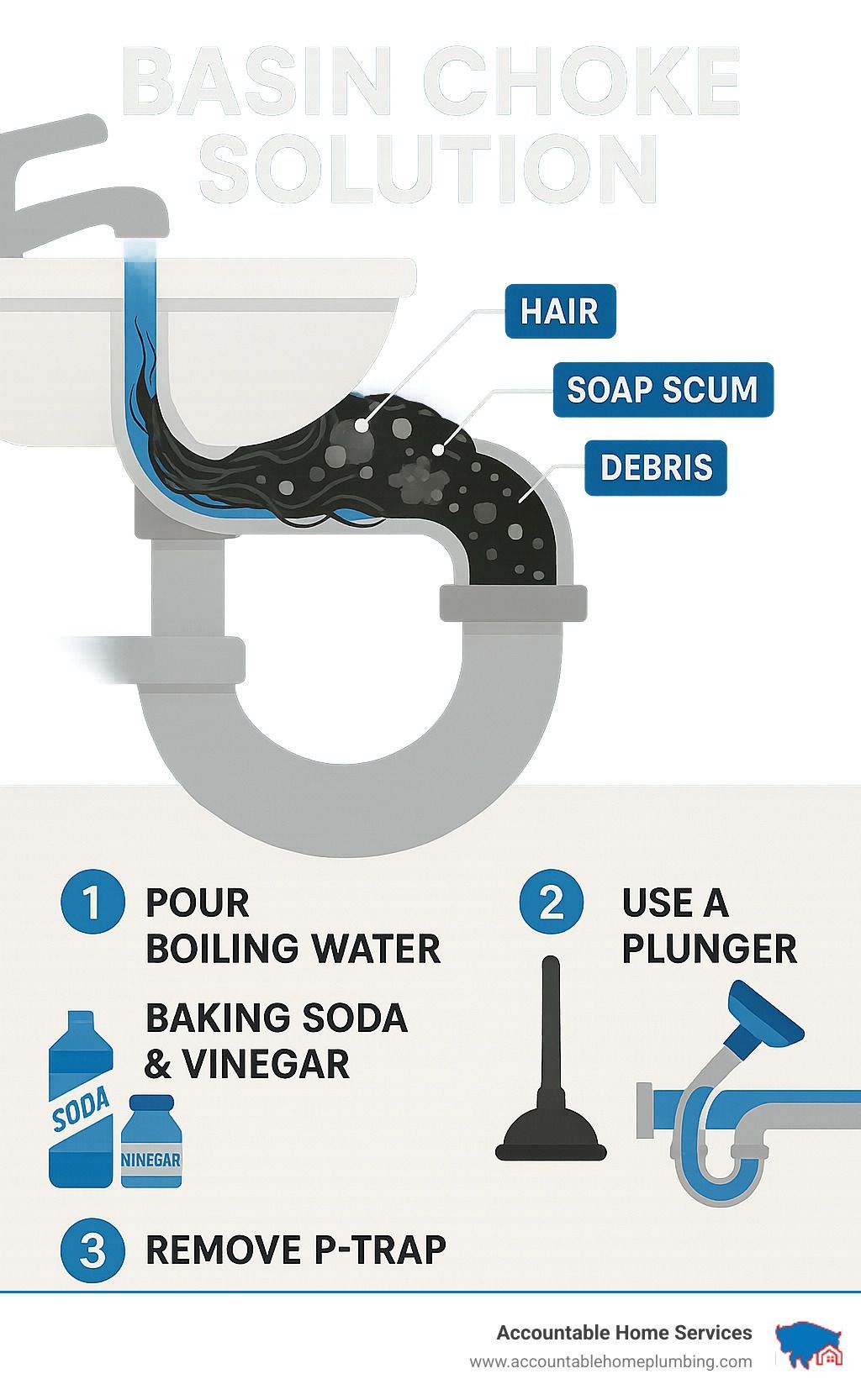
Why DIY Matters
When your bathroom sink starts draining slowly, your first instinct might be to call a plumber. But before you reach for the phone, consider this: according to our service data, approximately 80% of basin clogs can be resolved without professional help. DIY solutions not only save you money (the average plumber service call in Denver costs $85-150 just to diagnose the problem), but they also provide immediate relief.
Many homeowners don't realize that most basin chokes can be cleared in less than 30 minutes using items already in your home. Plus, natural cleaning methods like baking soda and vinegar are eco-friendly alternatives to harsh chemical drain cleaners that can damage your pipes over time and harm the environment.
What Causes a Basin Choke & Essential Toolkit
Ever stood at your sink watching water refuse to drain? You're not alone. In our years helping Denver homeowners, we've seen that bathroom sink clogs almost always come down to a handful of usual suspects.
Hair is the number one troublemaker – our plumbers find it in about 9 out of 10 bathroom sink clogs. Those strands from brushing, shaving, or washing collect in your drain and become a trap for everything else. Soap scum creates a sticky layer on pipe walls that catches passing debris. Toothpaste might seem harmless, but its thick consistency builds up over time, especially when mixed with hair. Personal care products like facial scrubs and shaving cream contribute to the problem, and occasionally foreign objects like jewelry or cotton swabs accidentally slip down the drain.
Most clogs happen in one of two places: either around the drain stopper assembly or in the P-trap – that U-shaped pipe under your sink. The P-trap isn't just a funny-looking pipe; it's designed to hold water that blocks sewer gases from entering your home. Sometimes the culprit might be a blocked vent pipe, which helps maintain proper air pressure in your plumbing system.
Before rolling up your sleeves to tackle a basin choke solution, gather these essentials:
A sink plunger (not the same as your toilet plunger), a bucket to catch water, rubber gloves to keep things sanitary, a drain snake or auger from your local hardware store, and a Zip-It tool – those plastic strips with barbs that catch hair like magic. You'll also want an adjustable wrench if you need to remove the P-trap, a flashlight to see what you're doing, and some old towels for inevitable splashes.
"Most homeowners already have half these tools lying around," says our lead technician. "And the specialized ones like a Zip-It cost less than $5 at any hardware store – much cheaper than calling us out, though we're always here when you need us!"
Spotting the Clog Location
Finding where your clog is hiding will help you choose the most effective basin choke solution. When water stands in the basin and drains painfully slowly, the clog is likely near the drain opening or in the P-trap. Hear gurgling after running water? That's often air trapped behind a blockage or a sign of venting issues.
Bad odors wafting from your drain suggest debris decomposing in the P-trap. If your sink has a pop-up stopper, it might be collecting hair and gunk at its base. And don't forget to check the overflow channel – that small hole near the top of your basin can develop its own clogs.
"When a customer calls about a slow-draining bathroom sink," explains our lead technician at Accountable Home Plumbing, "I first ask them to check if other fixtures are also draining slowly. If it's just the one sink, it's almost always a localized clog that DIY methods can fix."
Assessing Clog Severity
Not all basin chokes demand the same response. For minor clogs where water drains slowly but consistently, simple DIY solutions work beautifully. With moderate clogs, water might drain very slowly or stop occasionally before continuing – these may require combining several approaches. When facing severe clogs where water doesn't drain at all or backs up into other fixtures, you might need professional help.
Watch for red flags that signal bigger problems: multiple fixtures backing up simultaneously, sewage odors rising from drains, water backing up in unexpected places (like your shower causing toilet bubbles), or clogs that keep returning despite your best efforts.
If you have trees near your sewer line and experience frequent clogs throughout your home, you might have tree root intrusion – a problem that definitely calls for professional assistance. Our Drain Cleaning service can help with those tougher situations, or check out our guide to the Best Slow Drain Solution for more options.
"The good news," as I tell my customers, "is that about 80% of basin chokes can be solved without professional help. But knowing when to call in the pros can save you time, money, and a lot of frustration in the long run."
Step-by-Step Basin Choke Solution
Now that you understand what you're dealing with, let's dive into effective basin choke solutions. We'll start with the simplest methods and progress to more involved techniques.
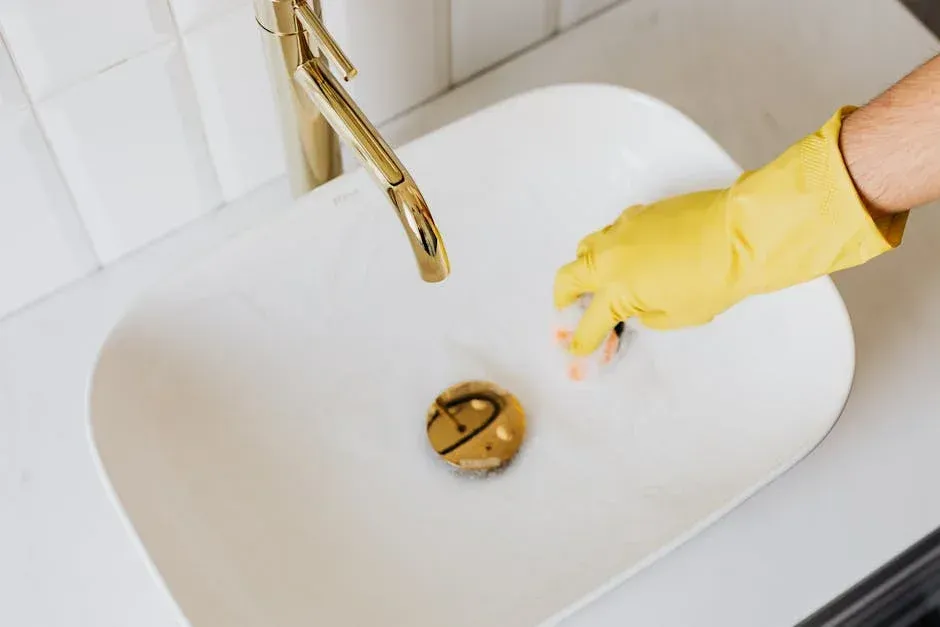
Safety first: Always wear rubber gloves when working with drains to protect yourself from bacteria and harsh chemicals. It's also crucial to check what material your pipes are made of – some methods that work beautifully for metal pipes could damage PVC or porcelain fixtures.
When choosing between natural and chemical methods, consider the trade-offs. Natural solutions like boiling water or baking soda with vinegar are safer for your family and the environment but might take a few attempts with stubborn clogs. Chemical cleaners work quickly but come with risks to your pipes, your health, and the planet. Our experience shows most bathroom sink clogs respond well to gentler approaches, saving the heavy artillery for truly stubborn situations.
Basin Choke Solution with Boiling Water
The simplest basin choke solution often works surprisingly well, especially for soap scum buildup. I can't tell you how many times I've arrived at a customer's home only to solve their problem with this basic approach.
Start by bringing a full kettle of water to a rolling boil. Carefully pour the boiling water directly into the drain in one steady stream – this creates pressure that helps break up the clog. Wait about 60 seconds to see if the water drains properly, and repeat 2-3 times if necessary.
"I'm always amazed at how often the boiling water trick works," says one of our Accountable Home Plumbing technicians. "About 60% of minor clogs clear up with just this step, especially in bathroom sinks where soap and toothpaste are the main culprits."
Important safety note: Only use this method if you have metal pipes. Boiling water can damage PVC pipes, porcelain sinks, and some types of sealant. If you're unsure about your pipe material, use very hot (but not boiling) tap water instead. Your pipes will thank you!
Basin Choke Solution: Baking Soda & Vinegar Blast
Remember those volcano science projects from elementary school? That same fizzy reaction makes this natural cleaning powerhouse an effective basin choke solution that's safe for most pipe types.
Make sure your sink is relatively dry first – you might need to bail out standing water with a cup. Then pour about ½ cup of baking soda directly into the drain, followed immediately by ½ cup of white vinegar. The mixture will bubble and fizz – that's exactly what you want! Cover the drain with a stopper or cloth to direct the bubbling action downward where it's needed most.
Let this natural chemical reaction work its magic for 15-60 minutes (longer for tougher clogs), then flush thoroughly with hot water for at least 30 seconds. The fizzing action helps break down organic material and soap scum without harsh chemicals.
"The baking soda and vinegar method is effective for about 70% of slow-draining sinks," notes our Broomfield service manager. "It's my go-to recommendation for customers who want to avoid chemical cleaners, especially those with kids or pets."
For particularly stubborn clogs, try leaving the mixture overnight before flushing with hot water in the morning. You might be surprised at the difference a little extra time makes!
Plunger Power for Stubborn Chokes
When simple solutions don't cut it, it's time to bring in some mechanical force with a plunger. The key to success here is creating a proper seal and using the right technique.
If you have a double sink, first seal the other drain with a wet cloth or stopper – otherwise, you'll just be pushing air back and forth between drains. Fill the clogged sink with enough water to cover the plunger's rubber cup (about 3-4 inches), then position the plunger directly over the drain, ensuring a good seal.
Pump vigorously up and down for about 15 seconds, then remove the plunger to see if water drains. You may need to repeat this process 2-3 times for stubborn clogs. The pressure created helps dislodge whatever's causing the blockage.
Pro tip: Use a sink plunger, not a toilet plunger. Sink plungers have a flat rubber cup, while toilet plungers have a flange at the bottom. Using the right tool makes a significant difference in effectiveness. Also, if your sink has a dishwasher connection, be sure to clamp or plug that line before plunging to prevent backflow into your dishwasher – trust me, you don't want that mess!
Snaking & Zip-It Like a Pro
For clogs that resist gentler methods, mechanical removal becomes your next basin choke solution. These tools physically grab or break up the clog, making them especially effective for hair-based blockages.
The Zip-It tool is incredibly simple but amazingly effective. This long plastic strip with barbs can be inserted into the drain as far as it will go. Give it a slight twist and pull it out – prepare to be grossed out by what comes up! Clean off the hair and debris, then repeat until the tool comes out clean. At around $2-5, this inexpensive tool pays for itself the first time you use it.
"The Zip-It tool is my secret weapon for bathroom sinks," shares our Westminster technician. "In my experience, it resolves about 90% of hair-based clogs in minutes, and homeowners are always shocked at how much hair comes out."
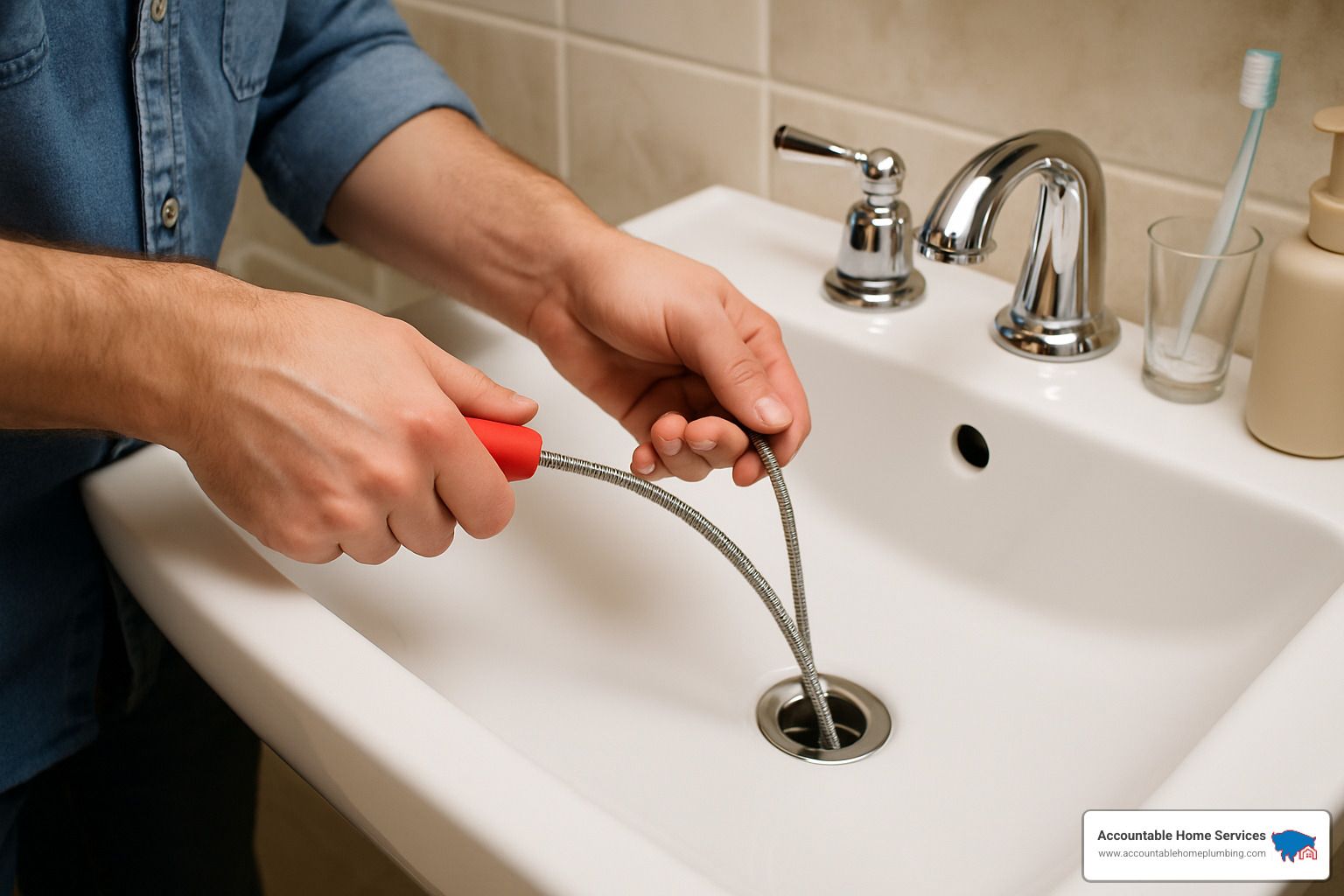
For deeper clogs, a drain snake (also called an auger) provides more reach. Feed the end of the snake into the drain opening until you feel resistance – that's your clog! Crank the handle clockwise to either hook onto the debris or break it up. Once you've worked through the blockage, pull the snake out, clean off any debris, and flush the drain with hot water.
For those struggling with a pop-up stopper that's in the way, check out this helpful guide on stopper removal that walks you through the process step by step.
Deep Dive: Remove & Clean the Stopper and P-Trap
Sometimes the clog is hiding in plain sight – right in your drain stopper or P-trap. Taking these apart for cleaning can resolve even stubborn clogs that other methods can't touch.
For the pop-up stopper, look under the sink and locate the pivot rod – that's the horizontal rod connected to the stopper. Squeeze the spring clip and disconnect the pivot rod from the clevis strap (the vertical metal strip). You might need to unscrew the pivot rod depending on your sink model. Once disconnected, you can pull the stopper straight up and out of the drain. You'll likely find a disgusting amount of hair and gunk – clean it thoroughly before reinstalling everything in reverse order.
Cleaning the P-trap requires a bit more work but is often where the most stubborn clogs hide. Place a bucket under the P-trap to catch water, then loosen the slip nuts on both ends using an adjustable wrench (turn counterclockwise). Remove the P-trap and empty its contents into the bucket – this might be unpleasant but satisfying when you find the culprit!
Use an old toothbrush to scrub the inside of the P-trap and check for clogs in the connecting pipes. When reassembling, tighten the slip nuts by hand first, then give them a quarter-turn with the wrench – overtightening can crack the trap. Run water to check for leaks before celebrating your victory.
"When I clean a P-trap, I always inspect the washers for damage," advises our Boulder service technician. "Damaged washers can cause leaks when you reassemble the trap. If they look worn, replace them—they only cost a few cents at hardware stores but can save you from water damage headaches."
Safe Use of Chemical Cleaners
While we generally recommend natural and mechanical methods first, sometimes chemical cleaners may be necessary for stubborn organic clogs that resist everything else. If you decide to go this route, do so with caution.
Choose a gel formula rather than liquid, as it stays in contact with the clog longer instead of just rushing past it. Always read and follow all label instructions carefully – these aren't suggestions but safety requirements. Ensure good ventilation by opening windows or using fans to prevent inhaling harmful fumes.
Never mix different chemical cleaners – this can create toxic gases that have sent people to the hospital. Pour the recommended amount directly into the drain, wait the full recommended time (usually 15-30 minutes), then flush thoroughly with hot water.
Important caution: Chemical drain cleaners can damage pipes with repeated use, especially older pipes or PVC. They're also harmful to the environment and can cause serious injuries if they splash onto skin or into eyes. Always wear gloves and eye protection when using these products, and keep them well out of reach of children and pets.
If you're looking for more thorough solutions, our Drain Cleaning and Best Slow Drain Solution pages offer additional professional insights that might help with your specific situation.
Prevention & Advanced Troubleshooting
The best basin choke solution is preventing the clog in the first place. After helping thousands of Denver homeowners with drain issues, I've noticed that people who take a few simple preventative steps rarely call us for basin clogs.
Installing a simple sink strainer screen is your first line of defense. These inexpensive little heroes (usually $2-5 at any hardware store) catch hair and debris before they can enter your drain. Our service records show that homes using strainers experience about 60% fewer clogs than those without them. That's a huge difference for such a small investment!
For metal pipes, a weekly flush with boiling water works wonders. This simple habit helps dissolve developing soap scum before it can build up and cause problems. Just boil a kettle and pour it straight down the drain – the hot water melts away potential blockages while they're still small.
Monthly maintenance with baking soda is another game-changer. Simply pour half a cup down your drain and follow with hot water. This not only helps absorb odors but also breaks down developing buildup before it can cause problems. I recommend setting a reminder on your phone – the first Saturday of every month is "baking soda day" in my house!
One absolute rule every plumber will tell you: never pour grease down any drain, even if it's liquid when you pour it. Once it cools, that grease solidifies and creates some of the most stubborn blockages we encounter. Instead, pour grease into an old can or container, let it harden, and throw it in the trash.
Brushing your hair before showering or washing your face can significantly reduce the amount of loose strands going down the drain. This simple habit takes just a few seconds but makes a big difference, especially for those with longer hair.
Don't forget to clean your pop-up stoppers regularly. These mechanisms are absolute magnets for hair and soap scum. A quick cleaning once a month when you do your baking soda treatment can prevent many clogs before they start.
Advanced Troubleshooting
Sometimes, despite your best prevention efforts, drain problems persist. This might indicate issues beyond a simple basin choke.
Check the vent pipe on your roof if you're experiencing ongoing drain issues. Your plumbing system needs proper venting to maintain pressure – much like a straw needs air to draw liquid. A blocked vent (often from leaves, animal nests, or even snow in Colorado winters) can cause slow drains throughout your home.
Watch for signs of systemic issues. If multiple drains are backing up simultaneously or your toilet gurgles when you use the sink, you're likely dealing with something more serious than a simple basin choke. These symptoms suggest problems in your main line rather than just the sink drain.
For persistent problems, a video inspection might be necessary. At Accountable Home Plumbing, we use specialized cameras to look deep within pipes and identify hidden issues. Last month, I visited a customer in Thornton who had tried every DIY method to fix recurring bathroom sink clogs. When we did a camera inspection, we finded tree roots had infiltrated their main sewer line. The sink was simply where the problem first became noticeable.
"Prevention isn't just about avoiding an inconvenience," I often tell my customers. "It's about protecting your home from water damage and avoiding costly repairs down the line." A few minutes of maintenance each month can save you hours of frustration and hundreds of dollars in emergency service calls.
For more comprehensive solutions to plumbing issues, check out our General Plumbing Services.
Frequently Asked Questions about Basin Choke Solutions
What household items work best for minor clogs?
When your bathroom sink starts draining slowly, you probably already have everything you need to fix it right in your kitchen cabinets. The most effective household heroes for tackling minor clogs are surprisingly simple.
Baking soda and vinegar might remind you of grade school volcano projects, but that fizzing reaction works wonders on organic buildup in your pipes. I recommend using ½ cup of each - pour the baking soda down first, follow with the vinegar, and let the science experiment work its magic for about 20 minutes before flushing with hot water.
Boiling water alone can be remarkably effective, especially for soap scum and toothpaste residue. It's my go-to first attempt for most bathroom sink clogs because it's free and takes just minutes.
Dish soap isn't just for greasy pans - a few tablespoons followed by hot water can help break down the oils in soap scum and personal care products that contribute to basin chokes.
"Nine times out of ten, I tell my Denver customers to try the baking soda and vinegar method before anything else," shares our Arvada technician. "Most people are shocked that something so simple actually works, but the chemistry behind it is perfect for dissolving the organic materials that typically clog bathroom sinks."
When should I avoid boiling water?
While boiling water is one of my favorite basin choke solutions, it's not right for every situation. You should skip this method if:
You have PVC pipes under your sink, as the extreme heat can warp, soften, or even damage plastic plumbing. Many newer homes in the Denver area have PVC drainage pipes, so check before trying this method.
Your sink is porcelain with any visible hairline cracks. The sudden temperature change can cause thermal shock, potentially turning those tiny cracks into bigger problems.
You've recently applied new sealant around your drain or fixtures, as the heat might affect how well it cures and adheres.
You've used chemical drain cleaners in the past 24 hours, as the heat could trigger a dangerous reaction with any residual chemicals.
If you're not sure about your pipe material, play it safe and use very hot tap water instead. It's gentler on all pipe types while still providing cleaning benefits. I've found that even hot tap water can dissolve minor soap scum if you're patient enough to let it work.
How do I know it's time to call a plumber?
While I'm all for DIY basin choke solutions, some situations signal it's time to bring in the professionals. Here's how to recognize when to pick up the phone:
Your sink keeps clogging despite multiple clearing attempts. This persistent problem usually indicates a deeper issue that DIY methods can't reach.
You notice water backing up in unexpected places - like your shower drain causing toilet bubbling or vice versa. This suggests a main line blockage that needs professional equipment to resolve.
Foul sewer gas odors persist even after you've thoroughly cleaned the P-trap. This could indicate a broken pipe or venting problem that needs immediate attention.
Your pipes make strange gurgling, banging, or sucking sounds when draining water. These noises often signal air in the lines due to improper venting or partial blockages.
Multiple drains throughout your home are slow or backing up simultaneously. This classic sign of a main sewer line problem requires specialized equipment to diagnose and fix.
You spot water damage around your sink cabinet base or on ceilings below bathrooms. This indicates a leak that needs immediate professional attention to prevent structural damage.
"About one in five basin choke calls we receive in Denver require our professional intervention," notes our operations manager at Accountable Home Plumbing. "Usually it's because the clog is located far beyond the P-trap or because there's a more serious underlying issue like tree roots or collapsed pipes that DIY methods simply can't address."
Attempting complex plumbing work without proper knowledge can sometimes turn a minor problem into a major headache. At Accountable Home Plumbing, we're always ready to step in when your basin choke solution needs exceed DIY capabilities. Our 24/7 emergency service covers the entire Denver Metro area, including Broomfield, Westminster, Thornton, Northglenn, Arvada, Boulder, Denver, and Longmont - because plumbing problems rarely happen at convenient times.
Conclusion
Dealing with a basin choke solution doesn't need to be a headache or drain your wallet. Throughout this guide, we've walked through effective methods that can save you from calling in the professionals. Start simple with boiling water or the baking soda and vinegar combo before moving on to mechanical approaches like plungers, Zip-It tools, or drain snakes.
I've seen how a little prevention goes a long way in keeping your pipes flowing freely. Installing an inexpensive drain screen, performing quick maintenance flushes once a week, and being mindful about what travels down your drain can spare you the frustration of standing in ankle-deep water during your morning routine.
At Accountable Home Plumbing, we believe in empowering homeowners with the knowledge to tackle common plumbing issues. But we also understand that not every clog surrenders to DIY methods. That stubborn basin choke that won't budge after multiple attempts? That's when our team steps in.
We're proud to serve the entire Denver Metro area with transparent, upfront pricing and absolutely no surprise fees. When you call us, what we quote is what you pay – whether it's a middle-of-the-night emergency in Broomfield or scheduled maintenance in Longmont.
There's no badge of honor for struggling with a persistent clog until 3 AM. Sometimes the smartest DIY decision is knowing when to call for backup. Our skilled technicians are your neighbors, ready to help 24/7 with the tools and expertise to resolve even the most stubborn basin chokes.
For emergency repairs when water is going everywhere except down the drain, 24/7 plumber assistance when disaster strikes at inconvenient hours, or professional drain cleaning when DIY methods have met their match, Accountable Home Plumbing is just a phone call away. We're committed to keeping Denver's drains clear and our customers smiling – because that's what good neighbors do.

